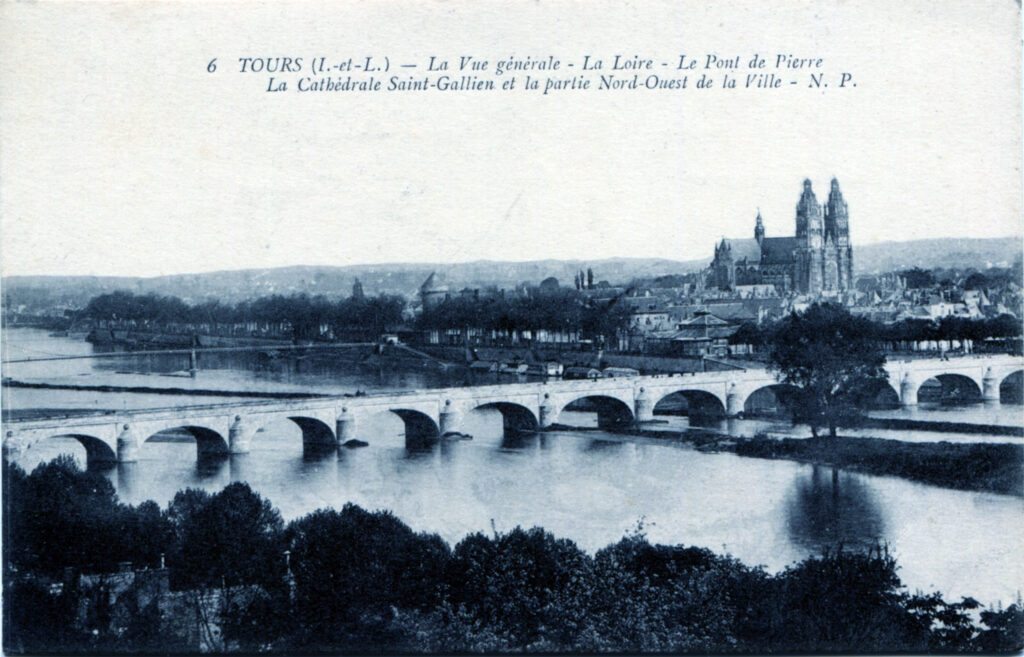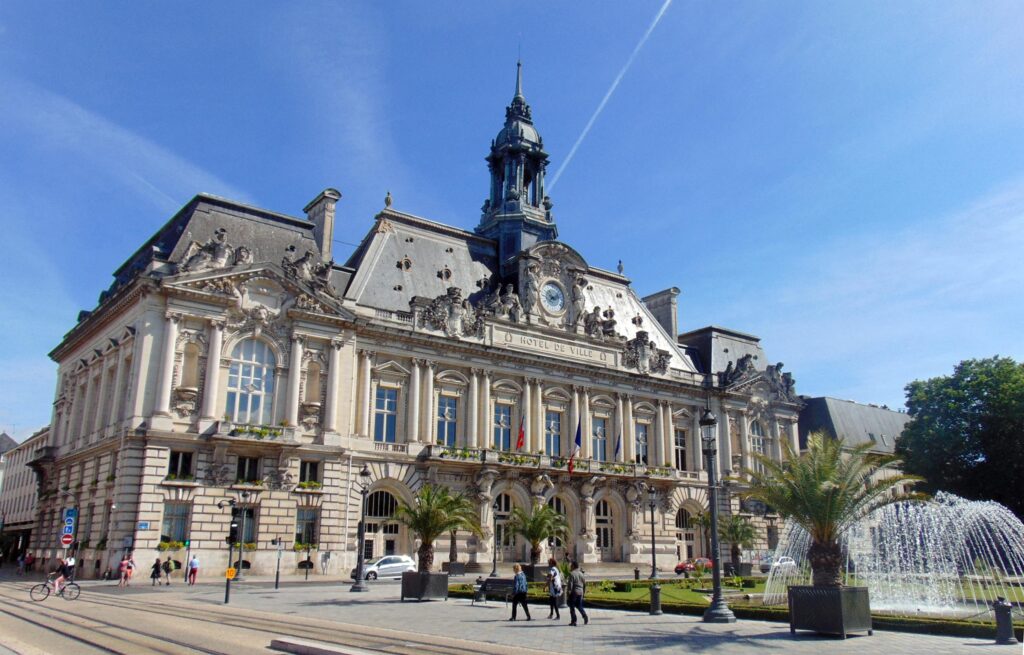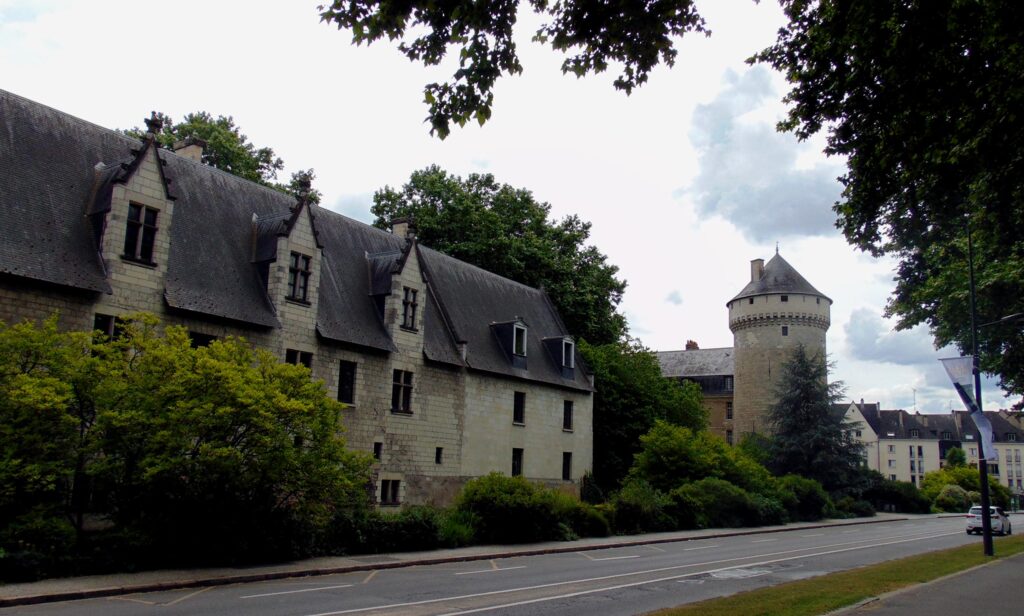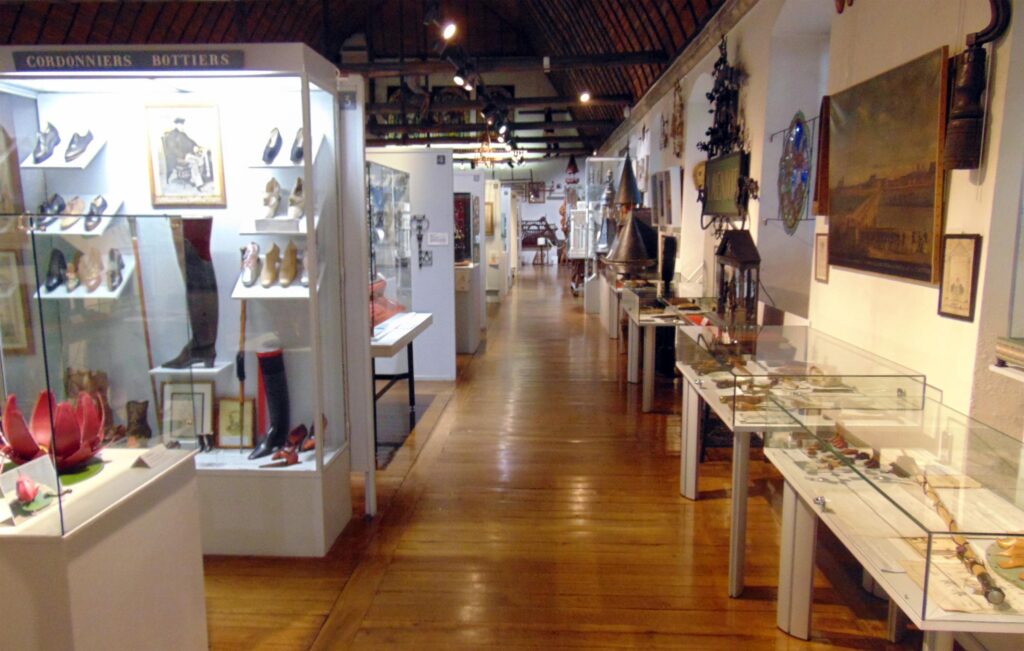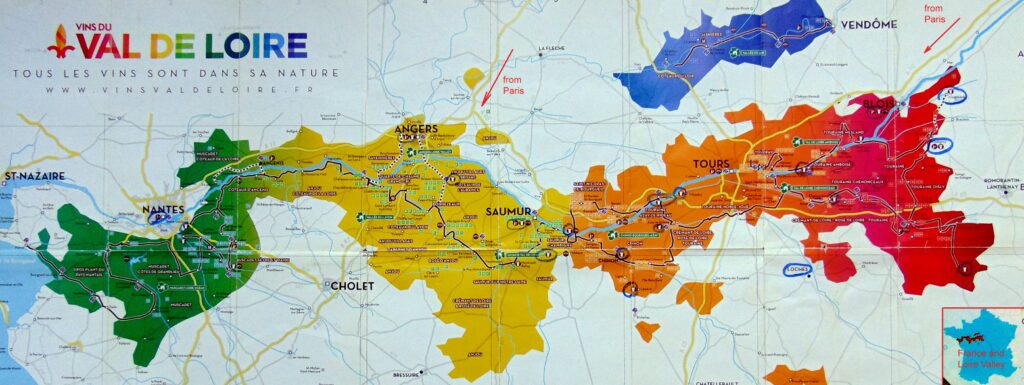Loire Valley tours from Paris Travel guide and tips: best castles & museums.
The city of Tours is located in the west of France, in the department of Indre-et-Loire, at the confluence of the Loire and Cher rivers and belongs to the Loire Valley region, about 2 hours from Paris by high-speed train or by a car on the highway, see the castles & wine map.
The brief history of the city and its locality.
Once upon a time in pre-Roman times, the Gallic tribe of the Tourons lived in the area of the city of Tours. After the Romans conquered their territory, a city was founded on the left bank of the Loire, called Turonemsis (or Caesarodunum – “Caesar’s Hill”). In the middle of the 3rd century, the missionary Gatianus (Gratien or Gratien) was sent here from the capital of the empire to form a Christian community. At the beginning of the IV century. the city received the status of the center of the III district of Lyon, Saint Martin (early 370 – 397), a former Roman soldier, who, after meeting with a beggar in Amiens, converted to Christianity, became the 3rd bishop of Tours and pursued a very active missionary policy, was appointed archbishop in Caesarodunum. Later, the population of Tours was also Christianized, the city became important for pilgrimage, received the blessing of Rome at the Council of Chalons in 813. In 573, the Frankish historian Gregoire of Tours, the author of Ten Books on the History of the Franks, later recognized as a saint, became Bishop of Tours.On October 10, 732, the Frankish royal majordomo Charles, later nicknamed Martell (“Hammer”), in a fierce battle at Poitiers defeated the army of the Arabs under the command of the Emir of Cordoba Abd-el-Rahman, which prevented the conquest of Western Europe by the Moors. According to some modern historians, the battle took place not at Poitiers, but on the road between Poitiers and Tours. Under the Frankish kings, Tours was a special county, later called Touraine. From the cloak (“cappa” – kappa) of Saint Martin led its name to the dynasty of the kings of France – the Capetians. Hughe Capet was a layman of the chapter of St. Maarten of Tours and successive and succeeding kings of France retained this title. According to this etymology, the building of the monastery of the same name included a palladium of the Franks, called the chapel (“capella”), from where the relic of Charlemagne was previously transferred to the famous court chapel of E-la-Chapelle. At the end of the “old regime” Saint Martin of Tours remained a symbol of Franco-French unification. In the 8th century an academy was founded in Tours, where handwritten books were created (including decorated with miniatures). There was even a special style of writing letters. Those ancient manuscripts are still kept in the city library. In the ninth century the city was surrounded by a defensive wall, called “castrum”, based on the amphitheater. In 845 Tours repulsed the first attack of the Vikings led by their leader Hasting. However, in 850 the Normans took control of the Loire, and in 853 and 903. they sacked the city.
At Tours in 461, 567, 755, 813, 1055 and 1163, the several local councils were held.
During the reign of the King of France (the first to bear this title, before that they were called “kings of the Franks”) Philip II Augustus (1165 – 1223), the Tourist livre began to be used as the international currency of the whole country. In the 15th – 16th centuries. various crafts began to actively develop in Tours, including the Huguenots, who created silk-spinning production here. However, after the abolition of the Edict of Nantes on freedom of religion and the flight of the Huguenots from France, this type of craft completely disappeared here.
In the spring of 1429, in Tours, Jeanne d’Arc was preparing her campaign against Orleans.
By the will of King Louis XI in 1461, the capital of the French kingdom was moved to Tours. Henry III in 1583 transferred here the Parliament (States General). However, Henry IV found it necessary to return the capital of the kingdom to Paris and moved there himself. In November 1845, a railway was built – the Paris-Orleans line and Tours became an important transport hub. It was and remains to this day the largest center of French winemaking.
1870-1871 Franco-Prussian War. The city was badly damaged, since from September 11 to December 10, 1870, the headquarters of the government of national defense, organized by the Minister of the Interior and Defense (L. Gambetta), met in Tours. The transfer of the “capital” was associated with the occupation of Paris by Prussian troops.
During the First World War, Tours was a rear city, but since 1917 it was the base of American troops who arrived in Europe to support the allies, and the city hosted a textile factory, workshops for sewing military uniforms, a military post office and a hospital.
In 1920, the Congress of Tours in the hall of the Manege, which does not exist today, proclaimed the collapse of the Socialist Party and announced the creation of the French Communist Party.
The Second World War: In 1940, the French government, evacuated from Paris, stayed in the city for some time. From June 20 to June 22, the center of Tours was completely destroyed by German incendiary bombs, more than 200 historical monuments perished in the fire. In May 1944, the Allied bombing had already contributed to the destruction of the city.
The extensive restoration of numerous historical monuments and reconstruction carried out in the city since the 1960s under Mayor Jean Royer, who was in power for 36 years, led to the almost complete restoration of Tours and turned it into one of the most elegant, well-groomed cities in France. Its “White” and “Blue” parts preserve the historical center regulated by UNESCO, as well as the historical city itself with old towers and other monuments of the past. In 2013 the tram returned to Tours.
The first bridge in Tours, built in the second half of the 18th century, constantly collapsed (the last time in 1978) or exploded. It consisted of 15 arched spans and is decorated with 2 large marble vases from the 18th century. In memory of American President T.V. Wilson in July 1918, he received the name “Wilson’s Bridge”.
Marmoutier Abbey (Great Monastery) was founded at the end of the 4th century. Saint Martin himself. In the middle of the 9th c. the Normans plundered and burned it. However, it was restored by the end of the 11th century. was one of the richest. But during the internecine feudal war, he again suffered very significant damage, and only by the beginning of the 13th century. the abbey was able to recover. During the religious wars of the 2nd half of the XVI century. the Huguenots again caused material damage to the monastery, and its temple and monastery suffered the most. During the era of the French Revolution, the monastery church and monastery again suffered damage – the first was turned into a stable, and the second – into a military hospital. In the next century, the abbey was returned to its former status.
The first buildings of the former Abbey of Saint-Julien (abbaye Saint-Julien de Tours) date back to the 12th century. In 1224 a strong hurricane broke out and the church and other smaller buildings were damaged. By 1240 it was restored. After the revolution of 1789, the abbey ceased to exist and there were stables for horses owned by guests of local hotels, and from the beginning of the 19th century. the monastery premises were used as a stagecoach station. Today, in the cells and the building of the chapter house of the abbey, there is the Museum of Winemaking (with a tasting room in the monastery cellars) and the Museum of Guilds (crafts) – in a neighboring building; its exposition exhibits shoes and furniture of local production, various products of stone cutters, blacksmiths, etc.
– Musée du Compagnonnage (museum of the Association of Guilds of Merchants and Craftsmen), more.
Tours also has a stained glass museum.
The botanical garden was laid out in 1843 and is the oldest park in the city. In 1848 and 1856 it was twice flooded by the waters of the Loire, but it was raised to the foundation and in 1863 a small zoo and greenhouse were added to it, and in 1890 new cold, temperate and hot greenhouses. During the Second World War, the botanical garden was significantly damaged by bombardments, but later it was restored.
The former Bishop’s Palace traces its history back to the 9th century. In the 60s. 18th century it was rebuilt and since 1910 turned into a museum, the basis of the collection of which was left by a private collection, bought out by the city municipality with the participation of several wealthy citizens. The palace houses the Museum of Fine Arts, whose collection includes over 12 thousand paintings, of which only about 1 thousand can be seen in the exposition, including a collection of Italian primitivists (including A. Vivarini, L. d Andrea, etc.), French painting until the 19th century. (C. Monet, E. Degas, E. Delacroix, etc.), a collection of Flemish and Dutch art (Rubens, Rembrandt), modernist art (M. Denis and M.E.V. da Silva) and a number of sculptural works by Rodin, Houdon, etc. The museum also contains frescoes by Mantegna, taken from Italy by Emperor Napoleon. In the courtyard there is a Lebanese cedar, planted under Napoleon and now turned into a huge tree.
The Hôtel Gouin, built in 1510, belonged to René Gardette, a descendant of a wealthy silk merchant’s family. In the 16th century The facade of the building has been remodeled. The name “Gouin” comes from the name of a family of Breton bankers who acquired the estate in 1738. In 1944, the mansion was almost destroyed by bombing, but in the 1950s. the main building with the entrance to it underwent partial restoration. Then the hotel housed the Archaeological Society of the Touraine region and now there is an archaeological museum.
The Basilica of Saint Martin had a very difficult fate – it was repeatedly built and destroyed. It was built in 471, in 853 it was burned by the Vikings, restored in 903, but burned down again in 997. After 20 years, a new temple was erected in its place, which also burned down in 1096. Within 5 years, from 1175 to 1180, the basilica was rebuilt again and stood unchanged until 1562, when during the religious wars it was plundered and partially destroyed by the Huguenots. Its remains were preserved until the era of the French Revolution, when stables were located here for some time, after which they finally turned into ruins. From the medieval abbey of St. Martin, in which there was an art workshop and where prominent miniaturists worked, only 2 towers have survived – Charlemagne (Charlemagne) and the Clock Tower, erected as early as the 11th century; in 1972 they were restored. The current building of the basilica was erected between 1886 and 1924. (according to other sources, it itself was built in 1902), now the relics of St. Martin, discovered in 1860, lie in it. The day of this highly revered saint is celebrated on November 11th.
The Cathedral of Saint-Gasien was erected on the site of 3 temples: the 1st, built in the 4th century. and dedicated to Saint Gascien, burned down; the 2nd, created in 561, was also destroyed by fire; in 590 it was replaced by a new one, erected by Gregory of Tours, was dedicated to Saint Martin, from 1170 it began to be rebuilt and in honor of Saint Gracien received his name in 1356. The work in the temple was finally completed in 1547. During the religious wars, it was plundered, but survived and during the French Revolution became the temple of the “new cult”, after which it was returned to the church a few years later. In 1862 it was given the status of a historical monument. Numerous stained-glass windows have been preserved in the cathedral, as well as the tomb of two children of Charles VIII and Anne of Brittany with a tombstone of the 16th century. The Cathedral includes an inner courtyard – the so-called. “psallet” (derived from the word “psalm”) – with a spiral staircase, in 1889 it became a monument of history and culture.
Tours Castle is one of the oldest buildings in the city. the first building in its place was built of wood as early as the 9th century. Since the 11th century, all buildings on its territory have been made of stone. From 1461, Tours became the capital of France, and Montil Castle (now Plessis Castle on the western outskirts of the city) became a royal residence until the 16th century. Later, in the 17th century, the royal castle was abandoned and in the next century it housed an almshouse. In the 19th century the castle housed a shot-making workshop and a farm.
In 1913 (according to other sources, in 1927) the castle became a historical monument. Before 2000 there was an aquarium in the castle, where there were up to 1.5 thousand fish and other species. The Gravin Museum was also located here. At the end of the 20th century the castle was acquired by the theater troupe Cano-Lopez. Now it houses the Museum of the History of Tours, exhibitions of contemporary art and photography are also held here.
Many beautiful castles, mansions of the French nobility also “moved” to Touraine, which could not help but contribute to the growth in popularity of the Loire Valley, which was becoming famous.
Many Frenchmen were born in Touraine, who later became famous: writers Francois Rabelais and Honore de Balzac, mathematician Rene Descartes and others.
– Tours in Tours 🙂 , how to visit.
- Private Loire Valley tours from Paris or Charles de Gaule airport by a car
Look at the map of the Loire Valley for the location of the city of Tours and the famous castles, and then choose the best route for your trip from Paris or Charles de Gaulle, Orly airport.

